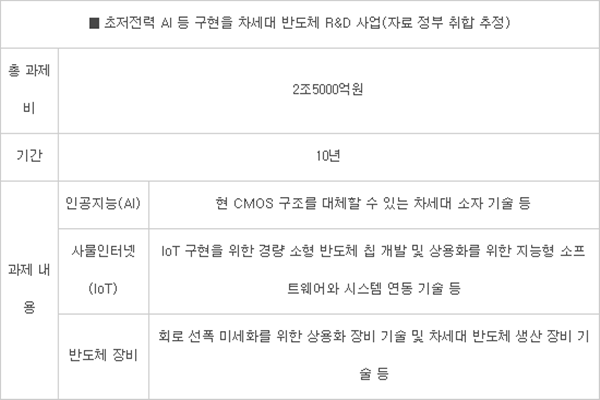South Korea is looking to start national semiconductor R&D project that are going to need $2.2 billion (2.5 trillion KRW) of investments very soon in order to grab an upper hand in next-generation semiconductor industries that will lead Industry 4.0 and to maintain its position as the powerful nation of semiconductors.
Ministry of Science and ICT (MSIT) and Ministry of Trade, Industry and Energy (MOTIE) are currently planning national semiconductor R&D project, which have duration of planning of 10 years, that cover every department. Semiconductor experts from government research institutes such as Electronics and Telecommunications Research Institute (ETRI), Korea Institute of Science and Technology (KIST), Korea Electronics Technology Institute (KETI), and Korea Research Institute of Standards and Science (KRISS) and about 50 university professors started participating in this planning since early this year.
MSIT and MOTIE are planning to request for preliminary feasibility tests from Ministry of Strategy and Finance and Korea Institute of Science and Technology Evaluation and Planning (KISTEP) after going through a public hearing in September. These tests are systems that examine economic feasibility of national project, which require large amount of fund, in advance. Excluding land developments such as roads, ports, and railroads, South Korea hardly attempts to do national R&D project that require more than $1.76 billion (2 trillion KRW) of investments.
“Because semiconductor is a number one export item of South Korea, it is a major industry that supports South Korea’s economy.” said a representative for a government research institute that is participating in this planning. “South Korean Government is making such decision because it believes that it needs decisive investments into R&D in order to separate its gap from its competitors such as China.”
Related government departments are predicting that national project will be carried out starting from second half of 2018 when preliminary feasibility tests pass this year.
This project is large divided into AI (Artificial Intelligence), IoT (Internet of Things), and equipment and materials related to production of next-generation semiconductors and will cover development of fundamental technologies and commercialized technologies. While fundamental technologies will be managed by MSIT, commercialized technologies will be managed by MOTIE.
Development of ‘super-low-power’ semiconductor device that is for implementing AI is included as part of development of fundamental technologies.. In order to use actual AI technologies properly in daily lives, experts in related industries say that current amount of electricity consumption needs to be reduced by 1,000 fold.
In order to reduce amount of electricity consumption, next-generation device technology that can replace CMOS (Complimentary Metal-Oxide Semiconductor) ,which is the foundation of current semiconductor device technology, needs to be developed.
‘Multi Value’ device technology has risen as a strong candidate that may replace CMOS. While CMOS performs calculations with 0 and 1, Multi Value can perform logical calculations with variety of values such as -2, -1, 0, 1, and 2. It is heard that development of nonvolatile memory technology with much faster speed that is optimized for calculation of Big Data and AI chip that can be used for consumer devices have also emerged as candidates that will be part of this national project.
Development of small and light chips will be part of national project that covers IoT field. Development of intelligent software for implementing IoT and development of total system solution are seen as candidates that will be part of this national project. It is heard that variety of technologies that will be able to produce these next-generation semiconductors will also be part of this national project. It is likely that development of fundamental technologies and commercialized technologies will be evenly distributed among tasks that involve IoT and development of equipment.
While goal of this national project is to develop next-generation technologies for semiconductor industry, which is South Korea’s major industry, and to grab an upper hand in markets, another goal of this national project is to train advanced and customized personnel that are needed by different industries.
“Because amount of investment for R&D of semiconductor fields was reduced by a lot by previous South Korean Government administration, industries are having difficult times in hiring manpower.” said an expert in semiconductor industry. “If number of universities and students who are in masters programs or Ph.D. programs that have gained experiences from this national project increases, it will greatly help in solving imbalance of supply and demand of manpower.”
Staff Reporter Han, Juyeop | powerusr@etnews.com
